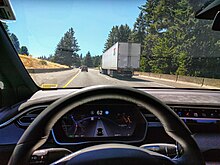
Back قيادة تيسلا الآلية Arabic Tesla Autopilot German Tesla Autopilot Spanish Tesla Autopilot French Tesla Autopilot Hungarian Tesla Autopilot Swedish เทสลาออโตไพลอต Thai 特斯拉自动驾驶 Chinese

Tesla Autopilot is an advanced driver-assistance system (ADAS) developed by Tesla that amounts to partial vehicle automation (Level 2 automation, as defined by SAE International). Tesla provides "Base Autopilot" on all vehicles, which includes lane centering and traffic-aware cruise control. Owners may purchase an upgrade to "Enhanced Autopilot" (EA) which adds semi-autonomous navigation on limited access roadways, self-parking, and the ability to summon the car from a garage or parking spot. The company claims the features reduce accidents caused by driver negligence and fatigue from long-term driving.[1][2] Collisions and deaths involving Tesla cars with Autopilot engaged have drawn the attention of the press and government agencies.[3]
Full Self-Driving (FSD) is Tesla's branding for its beta testing program to achieve fully autonomous driving (SAE Level 5). The naming is controversial, because vehicles operating under FSD remain at Level 2 automation and are therefore not "fully self-driving" and require active driver supervision. FSD adds semi-autonomous navigation on city streets and the ability to respond to traffic lights or stop signs. As of February 2023[update], Tesla cited about 360,000 participants in the beta program.[4] Industry observers and academics have criticized Tesla's decision to use untrained consumers to validate beta features as dangerous and irresponsible.[5][6][7][8]
The company's stated intent is to offer fully autonomous driving at a future time, acknowledging that technical and regulatory hurdles must be overcome to achieve this goal.[9] Since 2013, Tesla CEO Elon Musk has repeatedly made inaccurate predictions for Tesla to achieve Level 5 autonomy within one to three years,[10] most recently predicting the end of 2023.[11]
- ^ Williams, Elliot (March 4, 2019). "Does Tesla's Autosteer Make Cars Less Safe?". Hackaday. Retrieved March 5, 2019.
- ^ "Tesla Vehicle Safety Report". tesla.com. Retrieved April 29, 2024.
In the 4th quarter [of 2023], we recorded one crash for every 5.39 million miles driven in which drivers were using Autopilot technology. For drivers who were not using Autopilot technology, we recorded one crash for every 1.00 million miles driven. By comparison, the most recent data available from NHTSA and FHWA (from 2022) shows that in the United States there was an automobile crash approximately every 670,000 miles.
- ^ Shepardson, David (March 18, 2021). "U.S. safety agency reviewing 23 Tesla crashes, three from recent weeks". Reuters. Retrieved May 19, 2021.
- ^ Bellan, Rebecca (February 22, 2023). "What to expect from Tesla's long-awaited FSD version 11". TechCrunch. Retrieved February 28, 2023.
- ^ Hawkins, Andrew J. (October 22, 2020). "Tesla's "Full Self-Driving" beta is here, and it looks scary as hell". The Verge. Retrieved January 2, 2021.
- ^ Mitrache, Vlad (October 26, 2020). "Full Self-Driving Beta Release Is Tesla's Most Irresponsible Move so Far". autoevolution. Retrieved January 2, 2021.
- ^ "Should Tesla be 'beta testing' autopilot if there is a chance someone might die?". The Guardian. July 6, 2016. Retrieved January 2, 2021.
- ^ Widen, William H.; Koopman, Philip (September 27, 2021). "Autonomous Vehicle Regulation, Does Tesla's Full Self-Driving Beta Release Comply with Law?". SSRN 3931341.
- ^ Golson, Jordan; Bohn, Dieter (October 19, 2016). "All new Tesla cars now have hardware for 'full self-driving capabilities'". The Verge. Retrieved October 22, 2016.
- ^ Lee, Timothy B. (May 7, 2021). "Tesla Autopilot director contradicts Musk's self-driving timeline". Ars Technica. Retrieved July 22, 2021.
- ^ Torchinsky, Jason (July 7, 2023). "Elon Musk Predicts Level 4 Or 5 Full Self-Driving 'Later This Year' For the Tenth Year In A Row". The Autopian. Retrieved July 9, 2023.
© MMXXIII Rich X Search. We shall prevail. All rights reserved. Rich X Search